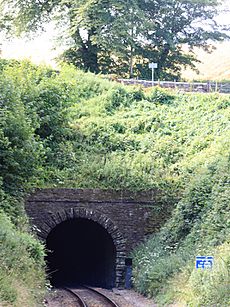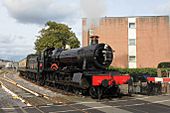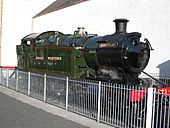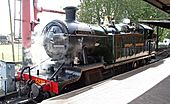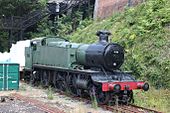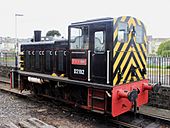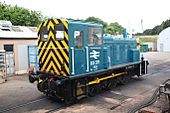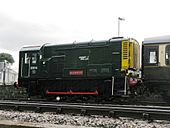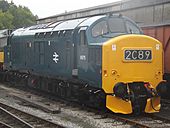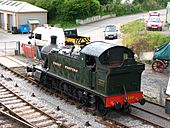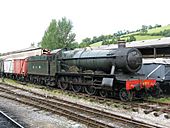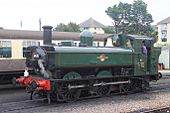Dartmouth Steam Railway facts for kids
Quick facts for kids Dartmouth Steam Railway |
|
|---|---|
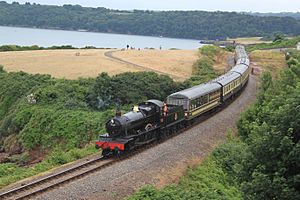 |
|
| Locale | Paignton, Devon, England |
| Terminus | Kingswear |
| Commercial operations | |
| Name | Kingswear branch |
| Built by | Dartmouth and Torbay Railway |
| Original gauge | 7 ft 1⁄4 in (2,140 mm) Brunel gauge until 1892 |
| Preserved operations | |
| Operated by | Dart Valley Railway PLC |
| Stations | 5 |
| Length | 6.7 miles (10.8 km) |
| Preserved gauge | 4 ft 8 1⁄2 in (1,435 mm) standard gauge |
| Commercial history | |
| Opened | 1859 |
| 1864 | Line completed |
| 1892 | Converted to 4 ft 8 1⁄2 in (1,435 mm) standard gauge |
| Closed | 1972 |
| Preservation history | |
| 1972 | Sold to Dart Valley Railway |
| 1981 | Turntable moved to Churston |
| 2011 | Heritage Festival marking 150 years of the line reaching Churston |
| 2012 | Greenway Halt opens to the Public |
| 2012 | New station building at Paignton opens |
| Headquarters | Paignton |
The Dartmouth Steam Railway is a special train line in Devon, England. It's 6.7-mile (10.8 km) long and runs along the coast between Paignton and Kingswear. Many people visit this railway in summer. They travel to Kingswear and then take a ferry across the River Dart to Dartmouth.
This railway is different from many other heritage railways. It's a business that makes money and doesn't rely on volunteers or donations. However, a few volunteers do help out at Churston railway station. The company that owns the railway, Dart Valley Railway plc, also runs boat trips on the River Dart. All these services are promoted together as the Dartmouth Steam Railway and River Boat Company.
Contents
History of the Line
Building the Railway
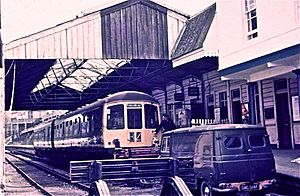
The railway was built by the Dartmouth and Torbay Railway company. The first part opened to Brixham Road station on 14 March 1861. The line reached Kingswear on 10 August 1864.
Later, bigger railway companies took over. The South Devon Railway Company ran the line first, then the Great Western Railway (GWR) took over in 1876. Brixham Road station became "Churston" in 1868 when a short line to Brixham opened.
There was a small stop called Kingswear Crossing Halt, or Britannia Halt. It opened in 1877 so the Prince of Wales could bring his sons to a naval college nearby.
Changes to the Tracks
The railway started with a very wide track, called a 7 ft (2,134 mm) broad gauge. But on 21 May 1892, it was changed to the 4 ft 8 1⁄2 in (1,435 mm) standard gauge that most trains use today.
The line had many bridges, including some made of wood over creeks. In 1923, the railway moved inland to avoid these creeks. This also helped a shipyard nearby to grow. In 1928, a wooden bridge at Waterhead Creek was replaced with a stronger concrete and steel one. This allowed heavier steam engines to use the line.
New stations and sidings were added over the years. Goodrington Sands station opened in 1928. More tracks for storing carriages were added at Paignton and Goodrington.
British Railways Era
In 1948, the Great Western Railway became part of British Railways. More sidings were built at Goodrington in 1956 to handle many trains during summer. A turntable for turning engines around was also added there.
In the 1960s, a report called the "Beeching Report" suggested closing many railway lines. Luckily, the Paignton to Kingswear line was not planned for full closure. However, some services were reduced. For example, Sunday trains stopped running in 1967. The line to Brixham closed in 1963.
Becoming a Heritage Railway
In 1968, there was a plan to close the line completely. But in 1972, the line was sold to the Dart Valley Light Railway Ltd. This company already ran another heritage railway nearby, which is now the South Devon Railway.
The railway started running a winter service in 1973, mainly for students. But it soon became a railway that mostly ran during the summer season. The company bought the line for £250,000. They sold some extra land to help pay for it.
An independent station called "Queens Park" was opened next to the main Paignton station for the Kingswear trains. The railway changed its name a few times, finally becoming the "Dartmouth Steam Railway."
In 1973, a famous locomotive, LNER Class A3 4472 Flying Scotsman, even ran on the line for a few days! In 1979, the passing loop at Churston was reopened. This allowed trains to pass each other, making it possible to run an hourly service in busy times. In 1981, a turntable was moved to Churston.
More improvements were made over the years. A workshop for locomotives opened at Churston in 1993. In 2007, another passing loop was added at Goodrington Sands. In 2012, the Paignton station was rebuilt in the old GWR style. A new station, Greenway Halt, also opened in 2012 to serve Agatha Christie's Greenway Estate.
Who owns the railway?
The Dart Valley Railway Company Ltd first bought the land for the Totnes to Ashburton line, which is now the South Devon Railway. On 30 December 1972, they also bought the Paignton to Dartmouth line.
In 2010, the South Devon Railway Trust bought the Totnes to Ashburton line from Dart Valley Railway plc. A businessman named Jeremy Hosking became a major owner of the Dartmouth Steam Railway in 2016.
How the Railway Works
The main base for the railway is at Paignton. Here you'll find an engine shed for storing and repairing trains. Bigger repairs for locomotives happen at Churston. There's also a workshop for carriages there.
The railway uses modern electric signals. A signalman at Britannia Crossing controls all the signals for the whole line. However, the level crossing near Paignton station is operated by the train crew themselves.
Most stations have ticket offices and places to buy food or souvenirs. But at Goodrington Sands and Churston, these are only open when it's busy. At other times, you can buy tickets on the train.
The railway also runs a bus service (number 100) between Paignton, Goodrington Sands, and Totnes. Some of these are open-top buses, which are great for summer. They connect with the train and boat services. The railway also works with the Kingswear Castle paddle steamer on the River Dart.
Steam trains run almost every day from April to November. They also run during parts of February, March, and December. Usually, trains have seven coaches. This is the longest they can be at Paignton without extra shunting. Diesel trains are only used if a steam engine breaks down or for special events. In December, they run special Santa trains.
The Route
The railway line is about 10.8 kilometers (6.7 miles) long. It starts from its own platform at Paignton, sometimes called Paignton Queens Park. The engine shed is built into the station building.
Right after the station, the line crosses Sands Road. Another track next to it is used by other train companies. There's a connection here so main line trains can visit the steam railway.
After Paignton, the train stops at Goodrington Sands station. Behind the platform are more tracks for storing carriages. The line then starts to climb up a steep hill. You'll see beach huts along Goodrington Beach. The South West Coast Path also runs alongside the line.
As the train goes past Goodrington Sands, Saltern Cove, and Broadsands, you get amazing views of the coast. You'll pass over the Broadsands Viaduct and Hookhills Viaduct. The line reaches its highest point at Churston. Here, you can see the turntable and sidings. This is where the old Brixham branch line used to join. Trains usually pass each other here.
From Churston, the line goes downhill. It passes under Greenway Road and then goes past Greenway Halt. Soon after, the train enters the 495-yard long Greenway Tunnel. After the tunnel, the River Dart appears on the right. The train crosses the Greenway Viaduct and goes through Long Wood, which is owned by the National Trust.
The line then turns east, leaving its original path. It crosses an embankment built in the 1920s over Longwood Creek. You can see the Noss Marina on the right. The train then reaches Britannia Crossing, a level crossing over the A379 road. This is where the signal box controls the whole line.
Between here and Kingswear, the line runs along the river's edge. You'll see a footpath on the right. After crossing the Waterhead Viaduct, the line reaches Kingswear station. A long bridge for people crosses the station. The station building has a special wooden roof, like those designed by Isambard Kingdom Brunel.
The ferry to Dartmouth leaves from right next to the station. Dartmouth railway station is unique because trains have never actually arrived there. Passengers always take the ferry from Kingswear. The old Dartmouth station building is now a restaurant.
Rolling Stock
Steam Locomotives
| Locomotive | Type | Photograph | Status | Livery | Notes |
|---|---|---|---|---|---|
| 2253 Omaha | USATC S160 2-8-0 | Operational | Canadian Pacific plum | This engine was built in 1943 and helped during World War 2. It later worked in Poland before coming to the UK for preservation. It was named "Omaha" to remember D-Day veterans. | |
| 7827 Lydham Manor | GWR 7800 Class 4-6-0 | Stored awaiting overhaul | BR lined black | Built in 1950, this engine was saved from a scrapyard in 1970 and restored by the Dart Valley Railway in 1973. | |
| 75014 Braveheart | BR Standard Class 4 4-6-0 | Operational | BR lined black | Built in 1951, this engine was saved from a scrapyard in 1981. It was named "Braveheart" after the famous movie. | |
| 4277 Hercules | GWR 4200 Class 2-8-0T | Undergoing overhaul | TBA | Built in 1920, this engine worked on freight trains in South Wales. It is currently being repaired. | |
| 5239 Goliath | GWR 5205 Class 2-8-0T | Operational | GWR lined green | This engine was built in 1923 for pulling heavy coal trains. It arrived at Dartmouth in 1976 and has been restored several times. | |
| 4555 Warrior | GWR 4500 Class 2-6-2T | Operational, currently at the East Somerset Railway | GWR lined green | Built in 1924, this engine has been at Dartmouth since 1973. It was recently repaired and is currently on loan to another railway. | |
| 4110 | GWR 5101 Class 2-6-2T | Currently at the East Somerset Railway under restoration | N/A | Built in 1936, this engine was saved from a scrapyard in 1979. It is currently being restored and will run on another railway before coming to the Dartmouth Steam Railway. |
Diesel Locomotives
| Locomotive | Type | Photograph | Status | Livery | Notes |
|---|---|---|---|---|---|
| D2192 Titan | BR Class 03 0-6-0DM | Operational | BR black | This small diesel engine is used for moving carriages and wagons around the railway. | |
| 03 371 | BR Class 03 0-6-0DM | Operational | BR blue | This diesel engine is privately owned but is based at the Dartmouth line. | |
| D3014 Samson | BR Class 08 0-6-0DE | Operational | BR green | Used for moving carriages or engineering equipment at Paignton. | |
| D6975 | BR Class 37 Co-Co | Operational | BR blue | Built in 1965, this powerful diesel engine is used for heavier trains on the line. |
Engines that used to be here
| Locomotive | Type | Photograph | Status | Livery | Notes |
|---|---|---|---|---|---|
| 4588 Trojan | GWR 4575 Class 2-6-2T | Awaiting overhaul | GWR lined green, 'Great Western' Lettering | Built in 1927, this engine ran the first services on the railway after British Rail days. It was sold in 2015. | |
| 4920 Dumbleton Hall | GWR 4900 Class 4-6-0 | Awaiting overhaul | GWR lined green, 'Great Western' Lettering | Built in 1929, this engine was transferred to Paignton in 1988. It is currently waiting for repairs. | |
| 6412 | GWR 6400 Class 0-6-0PT | Operational | BR lined green, late BR totem | Built in 1937, this engine was used on the Dartmouth line for a while. It was later sold to other heritage railways. | |
| 6435 Ajax | GWR 6400 Class 0-6-0PT | Operational | BR lined green, late BR totem | Built in 1937, this engine was sold to the Bodmin and Wenford Railway in 2008. It used to pull long trains on this steep line. | |
| D7535 Mercury | BR Class 25 Bo-Bo | Operational | BR Blue | This diesel engine was mainly used in winter or to help with special trains. It left the railway in 2018. |
Other locomotives sometimes visit the railway. This might be to help out or to bring special trains from the main rail network. The Torbay Express is a regular visitor, running from Bristol on Sundays in summer. Famous visiting engines have included 5029 Nunney Castle and 60163 Tornado.
Coaches
The railway has 21 coaches, with 19 ready for use. Two coaches have been specially changed for other purposes.
Eleven of the coaches are British Railways Mark 1 corridor coaches. They are painted in the old GWR "chocolate and cream" colours. Many of them have nice names, often named after staff members or their children. Some coaches have been changed to make space for wheelchairs and pushchairs.
A special Pullman observation coach is often used. It was originally built for the Devon Belle service. You can ride in it for an extra charge and get amazing views of the railway. It was refurbished in 2012.
The other coaches are from old British Rail DMU trains. Seven of these are used for passengers. An eighth DMU coach is an exhibition coach at Kingswear. It tells the story of the railway and the local area. Another special coach is used as a classroom for the railway's apprentices.
Freight Wagons
The railway also has a collection of freight wagons. Sometimes, a freight train runs to take coal from Paignton to Kingswear for the PS Kingswear Castle paddle steamer.
There is also a special fire extinguishing train. It is ready to help put out fires, especially during dry summer weather. It is usually kept at Churston with a diesel engine attached. On very hot days, this fire train checks the whole line after the day's trains have finished. Other wagons are used for engineering work.
Images for kids
See also
 In Spanish: Ferrocarril de Vapor de Dartmouth para niños
In Spanish: Ferrocarril de Vapor de Dartmouth para niños



